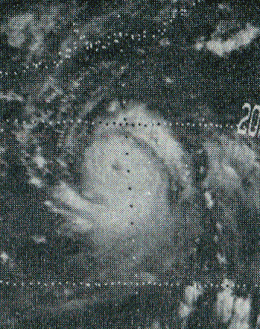Typhoon Marge (1973)
Typhoon Marge, known in the Philippines as Typhoon Ibiang, was a typhoon that formed in September 1973. The Chinese town of Jiaji in Qionghai, Hainan recorded a minimum central pressure of 937.8 hPa when Marge made landfall. 903 people were killed in Hainan when Marge made its final landfall in Thanh Hóa, Vietnam, on September 15, 1973.
| Category 1 typhoon (SSHWS) | |
 | |
| Formed | September 10, 1973 |
|---|---|
| Dissipated | September 15, 1973 |
| Highest winds | 1-minute sustained: 150 km/h (90 mph) |
| Lowest pressure | 965 hPa (mbar); 28.5 inHg |
| Fatalities | 903 total |
| Areas affected | Philippines and South China |
| Part of the 1973 Pacific typhoon season | |
Meteorological history
On September 10, 1973, a tropical depression formed in the sea east of the Philippines before moving to the east of Luzon. It made landfall on Luzon with the intensity of a tropical depression on September 11th. The tropical depression then moved into the South China Sea and was given the name Marge. On September 12, a U.S. reconnaissance plane detected a hurricane nearby and upgraded it to a typhoon. Due to the storm entering Chinese airspace, the US military stopped reconnaissance shortly after September 13th. The final reconnaissance recorded wind speeds at 80 knots. According to reconnaissance aircraft and ship data, the circulation was quite small, no more than 150 miles wide.[1] It made landfall in Boao in Qionghai, Hainan on September 14th, and it soon crossed the Beibu Gulf. Marge landed in northern Vietnam on September 15th and dissipated soon after.[2]
Impact

Hainan
On September 13th, Hainan Province was still unaffected by the circulation of Marge and the weather was humid. The weather forecast in a local newspaper, the Hainan Daily, only showed that the wind force would be 7 to 8 on the Beaufort Scale on September 14, providing an insufficient warning. By evening, there was still no sign of an impending typhoon.
According to data from the Central Meteorological Observatory, Marge landed on Boao in Qionghai, Hainan District at 4:40 am on September 14th. The wind at the center of the storm reached 60 meters per second and the pressure was 925 hPa.[3] During the landing, Qionghai's houses were almost completely destroyed. In Qionghai alone, there were 771 deaths.
The disaster report by the Revolutionary Committee of the Hainan Administrative Region to the Guangdong Provincial Party Committee showed that 90% of the houses collapsed, and some communes in Ding'an, Tunchang, and Changjiang also suffered varying degrees of damage.[4] According to data in the Qionghai Archives, the typhoon destroyed a total of 206,610 residential houses. 90,632 were completely destroyed, 29,946 suffered a partial collapse, and 86,03 were damaged. Almost 400 cattle died. More than 535 pigs were lost. Approximately 40% of the rice harvest was destroyed, and Qiuci lost 40,000 mu, accounting for 56% of the county's planting area that year. Sugarcane lost 16,000 mu, accounting for 40% of the planting area in Hui County that year. Rubber loss was about 2.32 million plants of 70,000 mu, accounting for 70% of the county's planting area that year. 80% of the rubber trees passed by the typhoon center were broken, and the losses were particularly heavy. The area's pepper trees suffered about 17,000 mu or about 997,000 plants. Forestry loss 12, ten thousand acres. The loss of Hainan Island in RMB cannot be calculated.[5]
Data from the Qionghai Meteorological Station on the north side of the landing site showed that it recorded a 10-minute average wind speed of 48 meters per second from 4:12 to 4:22 on September 14th. The anemometer was destroyed later and the maximum wind speed could not be obtained. A sea-level pressure of 937.8 hPa was recorded at 4:40. The Central Meteorological Observatory evaluated that the central wind reached 60 meters per second and the pressure was 925 hPa when Marge landed.[6]
Typhoon Marge killed 903 people and injured 5,759 in Hainan Province.[4]
Other
The National Disaster Risk Reduction and Management Council (NDRRMC) deployed search and rescue teams to support local authorities in ferrying people to safer ground.
References
- "1973 Annual Tropical Cyclone Reports" (PDF). U.S. Naval Observatory.
- "Typhoon 197314 (MARGE) - General Information". Digital Typhoon.
- "CMABSTdata". CMA. Archived from the original on 2014-07-14.
- "Typhoon 7314: A strong typhoon without warning". Hainan Daily. November 6, 2009.
- "Hainan Island 7314 Typhoon Disaster". Journal of Disasters1992-01.
- ""Typhoon Conference Collection 1974"". Shanghai People Publisher. Archived from the original on 2016-03-06.